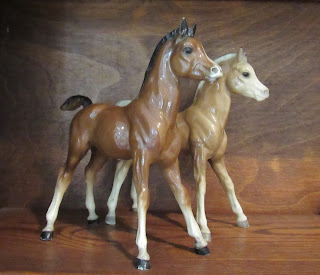"I just have to get that model," one friend said to me, of her grail du jour. "I conga that mold."
The verb form of "conga" means to dance that particular dance, but in model horsedom, it has also come to mean collecting every possible variation of a single model horse mold. (I guess you could also call it having a chorus line of small equines.)
Compared to most of my friends' collections, mine is pretty small. And generally speaking, I don't conga model horses. If I have one copy of a certain mold, I'm pretty happy.
But my recent trip to Breyerfest, a purchase from a friend, and a couple of other lucky finds allowed me to pick up multiple examples of some of my favorite miniature Hagen-Renaker molds: the American Saddlebred, the Morgan stallion, and the standing Arabian stallion.
I've always had a soft spot for the A-389 HR mini Morgan stallion.
 |
| Hagen-Renaker mini Morgan stallions. Left to right: 2007 Special Run in gray colorway; San Dimas palomino; Monrovia chestnut with "comma" eyes. |
Designed by Maureen Love, he stands 2.75 inches tall at the ears, and was released in matte chestnut and matte palomino from Fall 1959 to Fall 1973. He was re-released in four different glossy colors in 2007; only 50 of each color were produced as part of a set that also featured the mini Morgan mare and foal.
I think the three little stallions in my small conga line exemplify the reason collectors want variations on the same mold. Look at the differences in their detail, facial shading and expressions. They're all handsome for different reasons.
My longest mini HR conga line so far is the A-47 Standing Arabian stallion. Designed by Maureen Love, he is 3 inches tall at the ears and was produced in gray and white matte colors between Fall 1959 and Fall 1972.
I believe I bought my first HR mini Standing Arab stallion from one of the real treasures of the model horse hobby, Linda Walter. Linda has long been esteemed by her fellow collectors as the editor of the Model Horse Showers Journal (back in the day when such newsletters were painstakingly typed and illustrated by hand). Linda was, and is, one of the best at articulating the joy, the history and the ethics of model horse collecting.
I used to tell myself that I only needed one of these little guys.
 |
| HR mini Standing Arabian stallion, San Dimas doeskin color. |
 |
| The San Dimas mini Arab stallion on the left is slightly smaller and has a more pronounced matte finish than the one on the right. |
 |
| Headstudy of five Hagen-Renaker mini Arab stallions. |
Except that he's missing part of a leg. But I felt I had to bring him home from Kentucky; I couldn't leave him there....
I think I will send him to an artist friend for restoration. Then he can take his rightful place in the dance of the model horses.
_______________________________________
References:
Ed and Sheri Alcorn's Online Hagen-Renaker Museum:
http://hagenrenakerhorses.com/DirectoryHorses.html
The Charlton Standard Catalogue of Hagen-Renaker,
Second Edition, by Gayle Roller.
Hagen-Renaker Pottery: Horses and Other Figurines, by Nancy Kelly (a Schiffer Book for Collectors).
































